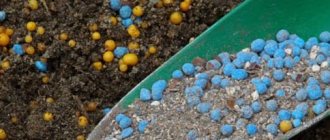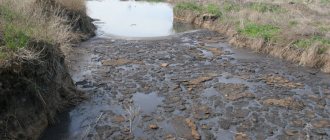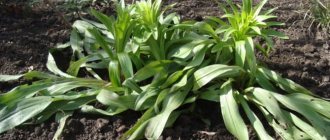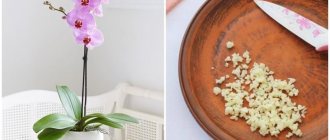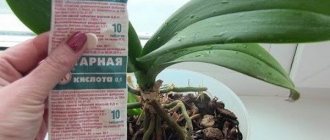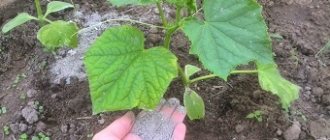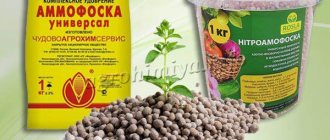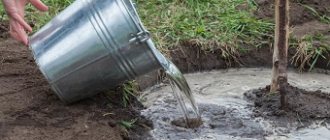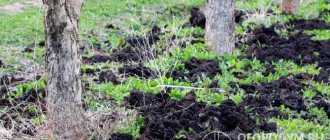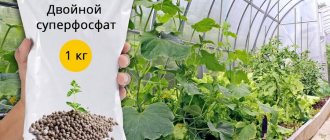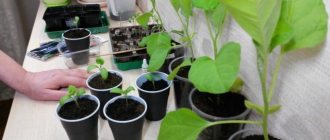Is it possible to fertilize?
An orchid can be fertilized, but only at the appropriate time:
- In spring, when the plant grows and gains strength for flowering.
- In summer, if the leaves continue to grow, but only until the first bud appears.
- With the onset of flowering, root fertilizers are replaced with foliar fertilizers.
- In autumn, while the plant is still blooming, you can fertilize only the leaves and aerial roots.
- In winter, the orchid needs rest, therefore, as soon as the plant has stopped growing, it is no longer worth fertilizing.
Is it necessary to do this?
Despite the fact that the orchid grows in a small volume of not very fertile soil, it still needs additional feeding.
On a note. Lack of nutrition will immediately result in chlorosis. This is a disease in which photosynthesis in the leaves is disrupted, they turn yellow and fall off, and the plant itself begins to lag behind in development.
To prevent this from happening, it is necessary to apply the necessary fertilizers in a timely manner. In addition, for lush flowering it is necessary to add phosphorus and potassium. Nitrogen is needed for the growth and development of shoots and leaves.
There are some prohibitions:
You cannot apply root fertilizer to a weakened plant!- You cannot feed the orchid immediately after transplantation! Only when the plant adapts, after about a month.
- You cannot fertilize a newly purchased plant! Wait for the end of flowering, the orchid should get used to the new place.
- Do not apply fertilizer at the root during the period of active flowering! Only foliar feeding on leaves and external roots.
- You cannot fertilize plants during very hot weather and active scorching sun!
Bottom line
Orchid is a beautiful tropical flower. The beauty of the plant lies in its lush, bright blooms. You need to be careful about her nutrition and care. Only compliance with all conditions will ensure active budding, lush flowering and new shoots.
What mineral fertilizer did you use?
You can select multiple answers or enter your own.
- Superphosphate 13%, 1163 votes
1163 votes 13%1163 votes - 13% of all votes
- Urea 9%, 798 votes
798 votes 9%
798 votes - 9% of all votes
- Nitroammophoska 8%, 690 votes
690 votes 8%
690 votes - 8% of all votes
- phytosporin*7%, 605 votes
605 votes 7%
605 votes - 7% of all votes
- Dolomite flour 6%, 538 votes
538 votes 6%
538 votes - 6% of all votes
- Potassium monophosphate 5%, 451 votes
451 votes 5%
451 votes - 5% of all votes
- Azofoska*5%, 433 votes
433 votes 5%
433 votes - 5% of all votes
- Calcium nitrate*5%, 407 votes
407 votes 5%
407 votes - 5% of all votes
- complex mineral and vitamin*4%, 374 votes
374 votes 4%
374 votes - 4% of all votes
- potassium magnesia, urea, potassium sulfate, ash*4%, 315 votes
315 votes 4%
315 votes - 4% of all votes
- saltpeter*3%, 297 votes
297 votes 3%
297 votes - 3% of all votes
- Ammophoska 3%, 281 votes
281 votes 3%
281 votes - 3% of all votes
- Diammofoska 3%, 280 votes
280 votes 3%
280 votes - 3% of all votes
- View answers*3%, 261 votes
261 votes 3%
261 votes - 3% of all votes
- manure*3%, 237 votes
237 votes 3%
237 votes - 3% of all votes
- Ammonium sulfate 3%, 235 votes
235 votes 3%
235 votes - 3% of all votes
- potassium nitrate*2%, 209 votes
209 votes 2%
209 votes - 2% of all votes
- ammonium nitrate*2%, 179 votes
179 votes 2%
179 votes - 2% of all votes
- Potassium sulfate, magnesium sulfate*2%, 157 votes
157 votes 2%
157 votes - 2% of all votes
- only manure*1%, 110 votes
110 votes 1%
110 votes - 1% of all votes
- Potassium chloride 1%, 110 votes
110 votes 1%
110 votes - 1% of all votes
- Borofoska*1%, 91 votes
91 votes 1%
91 votes - 1% of all votes
- potassium humate*1%, 90 votes
90 votes 1%
90 votes - 1% of all votes
- nitrophoska*1%, 68 votes
68 votes 1%
68 votes - 1% of all votes
- Nettle infusion*1%, 56 votes
56 votes 1%
56 votes - 1% of all votes
- Only ash*1%, 52 votes
52 votes 1%
52 votes - 1% of all votes
- Monoammonium phosphate, monopotassium phosphate, diammonium phosphate*1%, 49 votes
49 votes 1%
49 votes - 1% of all votes
- Anhydrous ammonia 0%, 40 votes
40 votes
40 votes - 0% of all votes
- Osmocote*0%, 32 votes
32 votes
32 votes - 0% of all votes
- gumi*0%, 26 votes
26 votes
26 votes - 0% of all votes
- ammophos*0%, 16 votes
16 votes
16 votes - 0% of all votes
- Quicklime*0%, 7 votes
7 votes
7 votes - 0% of all votes
- sulfoamophos*0%, 6 votes
6 votes
6 votes - 0% of all votes
- Nutrivant plus*0%, 3 votes
3 votes
3 votes - 0% of all votes
Total votes: 8666
Voted: 2078
01.04.2019 — 30.11.2022
* - added by visitor
×
You or from your IP have already voted.
What are the consequences of fertilizing during the flowering period?
Let's get this straight: during the flowering period, only root feeding is prohibited. If you ignore this rule, the orchid may shed existing flowers and not form new buds. We continue to apply foliar fertilizing. Otherwise, you can get the opposite effect in the form of leaf chlorosis.
Why can't you feed during the flowering period? The fact is that the orchid has already accumulated everything it needs before the peduncle appears. During the flowering period, it begins to expend previously accumulated energy. By applying fertilizers at the root, we provoke a refusal of flowering in favor of assimilation of fertilizers.
What to choose for a flowering plant?
As already mentioned, during the flowering period we use only foliar feeding. Now it’s time to figure out which fertilizers should be used.
At home
Possible options
- Universal complex fertilizers for flowering plants only if you really need it and there is nothing else. You need to take 3 times more water for dilution to make the solution less concentrated.
- Liquid fertilizer for orchids is a great option. Just dilute the fertilizer to feed a flowering orchid with double the volume of water compared to the recommendations in the instructions. A good option is Bona Forte for orchids, the price of a 285 ml bottle is 140-180 rubles.
- There are special fertilizer solutions for foliar feeding of orchids. They are available in the form of sprays.
It is very convenient to use. Reference. The English-made “Orchid Myst” product, 300 ml, will cost from 550. There are also Russian analogues, for example, Effect, 400 ml of which cost about 170 rubles.
Which fertilizers are not suitable
- Tablets and sticks for soil for orchids are unacceptable. In the soil for our beauty they will be distributed unevenly. Areas with high concentrations may damage roots.
- Various traditional methods can harm the plant. An orchid is a very delicate plant and requires careful concentration.
- It is better not to use universal complexes, only as a last resort.
On the street
In open ground, the orchid does not need fertilizer as much , but the same types of fertilizers as for indoor specimens are quite acceptable. For example, you can use Biona Flora fertilizer for orchids during the flowering period. The price of a 200 ml bottle is 110 rubles.
How else can you use complex fertilizers for orchids?
An effective way to fertilize is to place the pot up to the neck in a container with fertilizer for 20-30 minutes, then allow the fertilizer to drain freely through the drainage hole. This method is not suitable for newly transplanted, not rooted or not strengthened plants, since the orchid and substrate may simply float out of the pot.
You can also fertilize orchids from below through the drainage hole. The fertilizer solution is poured into a shallow container and the pot with the plant is placed in it for 1-2 hours. In this case, the moisture-intensive substrate gradually absorbs the fertilizer into the substrate lump from below, through the drainage hole. Then the pot is removed and the fertilizing is allowed to drain freely. In this way, you need to fertilize orchids of moisture-loving species and “precious” crops.
There is no need to water the plants again with the drained fertilizer, since, passing through the substrate, the solution changes its chemical (concentration, acidity) and microbiological properties.
In addition, repeated use of complex fertilizer for orchids can lead to infection of healthy plants with various pathogens - insects, fungi, bacteria and viruses.
This video shows how to properly fertilize orchids:
detailed instructions
Let's take a step-by-step look at the process of fertilizing at home and outdoors.
In room
At home, we fertilize as follows:
We fertilize 2 times a month, this is quite enough.
- We dilute the required amount of fertilizer.
- For foliar feeding, the fertilizer concentration is half the usual.
- Pour the solution into a spray bottle.
- The spray bottle should be such that it produces not a stream, but many small droplets.
- Shake the bottle before spraying so as not to end up with a more concentrated fertilizer that can burn the plant.
- Spray the leaves evenly on both sides and lightly spray the aerial roots. You shouldn't get them too wet.
- Do not spray flowers, the base of shoots and the growing point.
- Feeding should be done in the morning or evening.
- After spraying, you should not place the orchid in the sun.
Important! The leaves must dry to avoid burns. - You can do foliar feeding only in a warm room, the air temperature is from 18 to 26 degrees.
- The water for preparing the solution should be a couple of degrees warmer than the air temperature.
- The water should be soft and settled.
In the open ground
On the street we fertilize like this:
- We prepare a solution of warm water (about 20 degrees) and half the norm of fertilizer for orchids.
- Pour the prepared nutrient liquid into the spray bottle.
- Shake the solution again before applying.
- We spray only the leaf plates on both sides.
- We carry out foliar feeding either in the morning so that the leaves have time to dry before the midday heat. Or we do it during the day in cloudy weather.
- It is extremely undesirable to spray the orchid in the evening, otherwise at low night temperatures it will lead to diseases.
- You can fertilize twice a month.
How to dilute fertilizers for orchids in order to use them correctly
To avoid the appearance of salt encrustation on the leaves and roots of orchids, before diluting the fertilizer, you need to remember three basic rules:
- To prepare foliar fertilizers, use only soft, carbonate-free water;
- Use nutrient solutions with a low salt concentration of no more than 0.05% (0.5 ml/l);
- Between foliar feedings, rinse the plant, substrate surface or substrate block with clean, salt-free water.
Most orchids do not tolerate high concentrations of salts not only in irrigation water, but also in fertilizing.
To feed orchids characterized by CAM photosynthesis and low salt status, the concentration of the nutrient solution should be less than 0.1% (1 ml/l); for orchids characterized by switching C3-CAM photosynthesis with an average salt status, the concentration of the nutrient solution should be in the range of 0.1-0.2% (1-2 ml/l), and only for terrestrial C3 species with a high salt status the concentration of the nutrient solution may be more than 0.2% (more than 2 ml/l).
It is better that when feeding epiphytic orchids, solutions are used whose concentration does not exceed 0.1-0.05% (1-0.5 ml/l).
Root feeding
At the same time, we will consider the process of root feeding, which we will need before flowering in the spring. How to apply fertilizer at the roots:
Before fertilizing, you need to water the soil in the pot. Moist soil and roots saturated with moisture will guarantee the absence of burns.
- Dilute liquid fertilizer for orchids according to the instructions. Mix well.
- Pour the solution into a wide container so that the pot or pots can easily fit there.
- Place the orchids in this water for 20-25 minutes.
- Spread a small amount of solution over the surface of the soil.
- After time, the pot must be placed in a dry tray to drain off excess moisture.
- To prepare the solution we use only soft water.
Reference. If the water is hard, it must be boiled first. - The water temperature should be slightly above room temperature.
- After completing the process, the orchid should not be immediately placed in direct sunlight.
DIY nutritional mixture
In addition to store-bought fertilizers, you can prepare your own fertilizer. We have already given a number of examples above. Let's tell you more about their composition.
Eggshell
Most gardeners use it in large form, simply scattering it on the ground near the plants. In fact, this does not benefit plants; rather, it is necessary for birds. This is exactly how you can get new bait - bird droppings. But in order for the eggshell to become a nutrient for the flower, it is necessary to prepare it:
- dry and grind;
- pour the shell into a glass bottle, tightly closing the lid;
- put in a cool, dark place;
- after 2 weeks the water will become cloudy and an unpleasant odor will appear;
- dilute the solution with water in a ratio of 1 to 3.
Onion peel
It contains a whole complex of elements. It is rich in vitamins and organic acids. The husk strengthens the plant's immunity, enhances growth and repels pests. Onion peels can be added to the soil, or you can prepare an infusion for spraying.
Pour 1 cup of onion peel into a bucket of water, put on fire and bring to a boil. The remaining husks after straining can be used as compost. And use the resulting infusion for the leaves of the plant.
Potato decoction
The recipe is simple: boil the potatoes, drain the infusion and cool.
Starch for a plant is a kind of energy reserve ; when the plant is weakened, it will help restore its strength.
Garlic water
It is considered the most effective fertilizer. For 1 liter of water – squeeze out 1 clove of garlic through a press. The water must be at least +35 degrees. The resulting liquid is mixed and infused for 40 minutes, then filtered and used as a scheduled watering.
From the video you will learn how to make garlic water for watering orchids:
Banana peels
It is necessary to cut the peel and soak in warm water for several days. Then let it dry. Mix the resulting crusts with soil.
Or grind the dried skins in a coffee grinder and sprinkle this powder on the ground near the plant. Useful to stimulate flowering.
Coffee grounds
Valued for its high nitrogen content. It can be added to the ground.
Be sure to spread evenly and do not overwater the plant.
Dentifrice
If the leaves of a flower droop, the problem is in the root system. This means the plant was exposed to cold air or a draft. This happens in the winter season. To get rid of the problem:
- Dissolve 2 tablespoons of powder in half a glass of water.
- Add 1 tablespoon of vitriol and 2 tablespoons of wood ash.
- Mix everything thoroughly and apply to the stem of the flower at the root.
- Then stop watering for a week and move the plant to a dry place.
Useful video
Feeding orchids. When to fertilize them:
To keep your orchid healthy and beautiful, you can use the following products: Zircon, Fitosporin, Epin, Aktara, succinic acid, vitamins, garlic water, cytokinin paste, Fitoverm.
